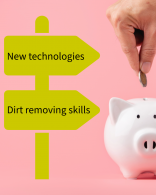Home › magazine › june july 2025 › latest news › The PandemicClean project: cleanliness and cost efficiency
The PandemicClean project: cleanliness and cost-efficiency
31st of January 2025For three years a team of industry experts has been gathering material on cleaning ergonomics and conscious cleaning. In the second of their exclusive articles for ECJ, Helge Alt from Puhastusekspert in Estonia and Tarja Valkosalo of Propuhtaus Finland (who have been involved since the start) tackle the theme of cleanliness and cost-efficiency.
The cleaning sector is under cost pressure all the time. Economic volatility, rising labour costs, and increasing demands for sustainable practices have made it more challenging for organisations to maintain standards of cleanliness while keeping expenditures in check. As budgets tighten, cleaning companies and facility managers are compelled to rethink their cleaning protocols and explore innovative ways to reduce costs without compromising quality.
As we know well, most cleaning costs are made up of staff costs. Traditionally, we have made savings by reducing the number of cleaning sessions. Often this has led to a reduction in the level of cleanliness.
Nowadays, new technologies can also be used for cleaning. Robots can replace some of the human work. IoT-based systems can monitor the use of premises, allowing us to schedule cleaning as needed and avoid unnecessary inspection visits.
Cleaning efficiency and result can also be improved without investing in technology. For example, Lean 5 S is a system that can combat wasted time associated with the cleaning process. One form of waste is the overall wasted effort caused by not getting surfaces clean by cleaning.
In the PandemicClean project we found that after cleaning surfaces could be dirtier than before cleaning. The cleaning method or activities were inadequate because the dirt was simply spread. In such situations, the time and money spent is wasted.
Every movement in cleaning work should remove dirt. We also found in the PandemicClean project that the fastest manual cleaning method is not necessarily the most effective for removing dirt. In addition to investing in technology, investment should be made in the training of cleaning staff.
We should not forget that cleaning is based on knowledge. We need to monitor and measure surface cleanliness and hygiene so that we know what level of cleanliness can be achieved by the cleaning methods in use and whether human resources are being used effectively. Otherwise, the idea of needs-based cleaning is not fully understood.
It is also necessary for the customer to monitor the quality of cleaning, so that he does not pay for an unfulfilled quality of service. It's a good idea from time to time to focus and remind yourself what the goal of cleaning is for each site.
Delivering the agreed quality of cleaning in a cost-effective way is a complex challenge that requires a multifaceted approach. By identifying cost-saving opportunities, enhancing staff skills, tailoring cleaning strategies, and implementing monitoring systems and robots, organisations can maintain high standards of cleanliness while managing costs.
Failure to navigate these challenges effectively can lead to detrimental outcomes for both cleaning staff and the users they serve. Organisations that prioritise effective cleaning practices will not only enhance their environments but also foster a culture of health, safety, and satisfaction.
The project's website can be found at: ergoclean.eu








